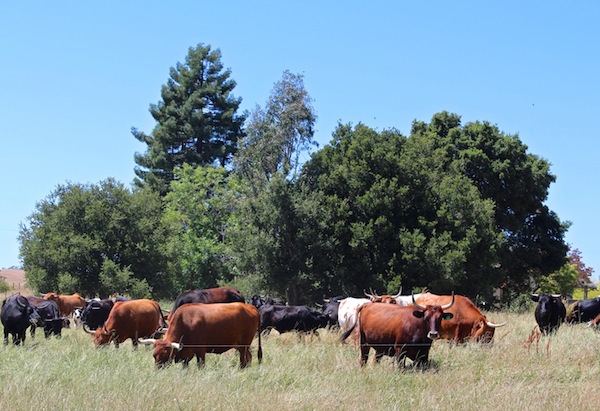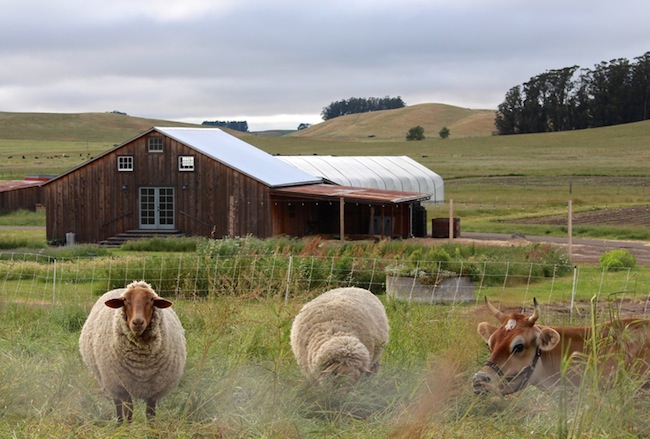The Regrarians Platform helps agriculture and natural landscapes coexist with grace.
It’s late spring on Open Field Farm in Petaluma. With summer’s arrival, the farm’s CSA offerings will expand from winter’s limited root vegetables and greens to abundant tomatoes, squash, cucumbers, and berries. Just like every farm in the area, Open Field is on the cusp of a familiar seasonal change, but owners and farmers Sarah and Seth James are anticipating an even bigger shift.
On a hot, dry weekend in May, Open Field hosted the Regenerative Agriculture Systems Design Convention. Educators, farmers, ranchers, and landscape designers gathered in a open-air barn, toured the 560-acre property, and conversed with experts in the regenerative agriculture field: Australian farmer Darren Doherty, Brock Dolman of the Occidental Arts and Ecology Center, and Erik Ohlsen of the Permaculture Skills Center. The ultimate goal was to learn more about Doherty’s Regrarians Platform—a design framework that integrates sustainable agricultural philosophies as a way to “regenerate and restore” landscapes.
The platform is based on Australian agriculturalist and engineer P.A. Yeomans’ “Keyline Scale of Permanence,” a tenant of the permaculture movement that emphasizes a whole-systems focus on agricultural land management. Doherty has added energy and economy to Yeomans’ themes: climate, land shape, water supply, farm roads, trees, permanent buildings, subdivision fences, and soils. The approach borrows from organic agriculture, holistic management, and permaculture. A self-proclaimed “integrationist,” Doherty believes these theories shouldn’t be applied in isolation.
“After 30 to 60 years these methods have become somewhat siloed,” he says.“Permaculture has become quite monotheist. Organic has become nothing.”
Humans need to start believing that they are perennial and stop behaving like an annual species DARREN DOHERTY
The Regrarians Platform seeks to “co-mingle” these ideas with humans and the landscape. By doing so, Doherty says, the sometimes ignored questions of quality of life and economic viability become central to a farmer’s or rancher’s plan. The platform emphasizes a long-term view instead of decisions made out of panic or desperation, one where fiscal discipline, marketing, and business planning can lead to personal and business security. It’s about taking time in the present to plan. And, it’s about listening to the landscape, which tells you what it needs if you ask the right questions.
“Humans need to start believing that they are perennial and stop behaving like an annual species,” Doherty says. The best way to learn about things like the Regrarians Platform, according to Doherty and his team, is to use it. By the fourth day of the convention, students were ready to fill in their own maps of the Open Field property—adding grazing land here, placing an orchard over there, and designing in a way that might help regenerate the farm and make it even more sustainable year after year.
For Seth and Sarah James, whose biodynamic farm is already based on whole-farm management and community involvement, these ideas resonate. Quick to admit that they’re still figuring out how to run their operation of row crops, cattle, chickens, and sheep, they’ve also created a vibrant 150-member CSA with a sliding scale “pay what you can, take what you need” credo that relies on the support of their community to recognize the value of the entire farm, including its labor force and ecological gifts.
Still, the Jameses have been challenged by clay soil and water access. Initially, they approached the Permaculture Skills Center to help them understand and manage irrigation on their land.
“We were brutally aware when we came here that we had to understand our water and how it’s behaving,” said Seth. He isn’t sure yet how he’ll implement the Regrarians Platform at Open Field, but the weekend convention caused him to rethink earlier decisions on the farm. For one, he realized how important it is to consider the landscape’s topography, water cycles, and geology when placing fields, grazing cattle, and trees. Orienting fields of row crops or an orchard around a drainage flow could cut down on thousands of gallons of water.
“As a community, we should be managing our watersheds, but instead we are managing fence lines,” he says. “It’s as if we all don’t depend on the flow of water for life.”
Open Field’s 85-head herd of Corriente cattle are nearly as important to the holistic equation as water. As a biodynamic farm, the Jameses’ work with animals as partners in land management. Seth understands that responsible grazing can “recharge” grasslands by promoting the perennial grasses that feed the soil effectively. But, he said, they could do this even more. He said he was “blown away” by how much harder farmers have to work when they don’t harness the animals’ influence on the land.
Seth is also attracted to the Regrarians Platform because it acknowledges that no matter how much a farmer is guided by natural cycles, agriculture is inherently about manipulation of the environment. The goal, however, isn’t to repair nature. Instead, it’s to figure out which of nature’s processes are present and how to work in harmony with them.
Seth compared Doherty and the Regrarians Platform to a formative experience he once had with a wizened local cattle rancher. Before the conversation, the young farmer knew what he wanted to accomplish, but upon learning from a master, he now has the tools to get it done.



